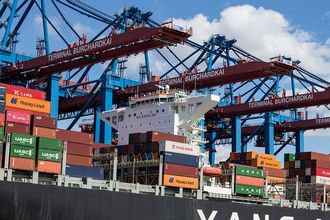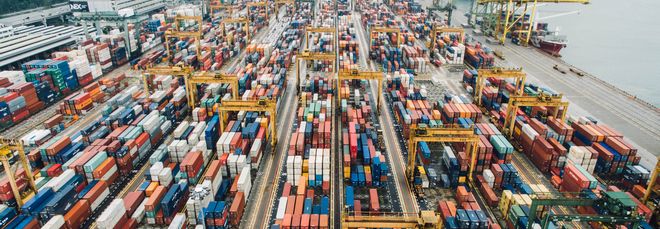Certain officer of the mid-sized leasing company explained their current leasing situation that their present container utilization hits 97% and there is no depot availability in China and Asia at all and most of their new production in the factory have already been reserved by Long Term by shipping lines. It is easy to imagine that this state would apply to the situation same for other lease companies. It is said that the major leasing company who is aggressively placing an order for the new containers seems to have ordered already over 500,000TEU this year. On the other hand, some major leasing companies who had been suffered from a considerable loss caused by bankruptcy of Hanjin Shipping lines or a canny leasing company who was less interest in ordering new containers due to the circumstances of their parent company have gradually been ordering new containers owing to not missing the current steady new container demand. The new container price in China is $2,200 per 20f and the new container stock in China factories maintains around 410,000 TEU.
According to Shipping Gide, in the middle of July, US Retail Trade Federation (NRF) gave a prospect of 1,710,000 TEU for July and 1,750,000 TEU for Aug about the retail-related container import to USA. And they expect that import of August will renew a record high for single month import after 2000. In addition, they are considering that the cargo movement reaches 1,700,000 TEU in October as well. They analyze that improvement of the employment and the income, the reduction of the debt would support consumption expansion. On the other hand, numerical value to prove favorableness of the economy in the United States was announced on August 4 by the U.S. Department of Labor. As for it, the number of the employees of the non-agriculture section of July is 209,000 increase compared with the month before. The unemployment rate improved 0.1 point to 4.3% from the last month.
According to the announcement of the Japan Maritime Center as for June cargo movement from Asia to North America decreased by 2.0% to 1,306,000 TEU from a year earlier. However, cargo movement total from Jan. to Jun. was 7,755,000 TEU (4.7% increase over the same period of the previous year). On the other hand, May cargo movement from Asia to Europe increased for the third month running to 1,430,845 TEU (7.5% increase from a year earlier). The total cargo movement from Asia to Europe reached a record high to 6,550,240 TEU (4.9% increase on year-over-year basis) in the period of from Jan. to May and the single month of May also recorded high.
Average container loading ratio of the containership from Asia to North America at the end of July would exceed 100% with Korean only ocean carrier, Hyundai Marchant Marine. The present spot freight rate rose more than $ 500 per FEU in comparison with the end of July. Cargo exported from Korea would see the loading peak from the mid of Aug to Oct. Therefore it is expected that a freight rate rises more by addition of Peak Season Surcharge (PSS) after the middle of August. The freight rate from Asia to US West Coast (USWC) raised by more than 50% to about $ 1,690 per FEU from the end of June. The freight rate for US East Coast (USEC) raised by 30% to about $2,690 per FEU. Container loading ratio of the containership has been attended to 95%, almost in full loading.
Japanese 3 shipping lines (NYK, MOL, K Line) announced their second-quarter current profit and loss that all 3 lines has become black figures such as NYK with 10.2 billion yen in black (9.9 billion yen in deficit as for the same period a year ago) and MOL with 5.8 billion yen in black (700 million yen in black for the same period a year ago), and K Line with 6 billion yen in the black (deficit of 22.5 billion yen for the same period a year ago).
When we look only in a liner section their results have largely improved like NYK shows 5.7 billion yen in black (deficit of 8.8 billion yen as for the same period a year ago), MOL shows 6.2 billion yen in deficit (deficit of 11.6 billion yen as for the same period a year ago) and K Line with 6.1 billion yen in black (12.3 billion yen in deficit as for the same period a year ago).
Preparations of Ocean Network Express (ONE) consolidated by liner section of Japanese 3 shipping lines have been pushed forward towards a business start from next April smoothly. The business operator with capital of 200 million US dollars are established in Singapore, and the operation scale is approximately 144 ships, 1,440,000 TEU; the sixth place of the world. The operation scales will increase to approximately 1,750,000 TEU by new ship injection in the next two years and make rapid progress to the fifth place of the world.
After next April, the world containership industry will be occupied 63% of world shared by six major companies (Maersk, MSC, COSCO+OOCL, CMA-CGM, Hapag-Llyd, ONE (Japanese 3 shipping lines)).
 Oligopoly advances to the container leasing company, and it is thought that five top ranks (Triton, Seaco, Textainer, Florens, Seacube) occupy 80% of the whole.
Oligopoly advances to the container leasing company, and it is thought that five top ranks (Triton, Seaco, Textainer, Florens, Seacube) occupy 80% of the whole.
Shipping companies may consider that supply ability of containers is enough with the current mega-leasing companies when they lease but in a sense we cannot help but say that it is considerably dangerous. The lease condition in the seller’s market like the present conditions cannot but become considerably severe for the shipping company. The long-term lease rate of the hovering high, round trip use with redelivery to China and Asia is requested for favor to leasing companies. By combination of Leverage Lease with pick-up of containers from North America and or Europe. If a certain major leasing company could draw an advantageous condition from the shipping company for the leasing company, other major leasing companies follow it, and it cannot but be in a similar severe lease condition. If shipping lines could not accept such leasing terms it would be hard for them to secure necessary quantity of containers at right place and right time from leasing companies. This would be more or less the present situation.
It is important that the major shipping lines should have room bringing up small and medium sized leasing companies in order for them to avoid such situation as much as possible and let a healthy competition principle work among major leasing companies. The small and medium sized leasing companies plan survivors to compete with major leasing companies by showing some flexible lease conditions and plan the growth to the bigger lease companies. Shipping lines should utilize such a small and medium sized container leasing company well, and it is essential for shipping lines let the leasing companies introduce a competition principle as much as possible. It may be said that the shipping lines were able to afford to raise small and medium sized leasing companies in 1980s when Triton and Textainer were born. As a result, Triton and Textainer who were the nameless companies could compete with the existing major leasing companies at that time and were able to grow up in the current major lease company. They are now proud of No.1 and No. 3 largest leasing companies in the world.
In that sense I would like to give my frank advice that shipping lines should not ignore the small and medium sized leasing companies in order for them to make leasing companies a good partner and it would be the key success factor for shipping lines to make themselves successful to great extent.
